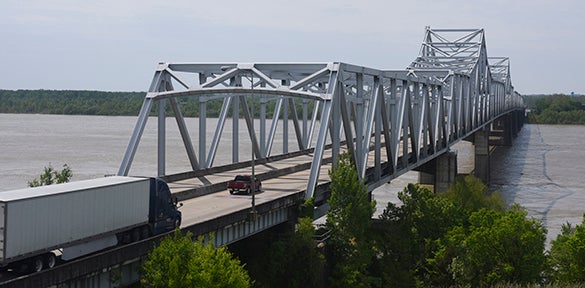Vicksburg Bridge deficient?: Analysis concludes I-20 structure still safe, but in need of repairs
Published 9:27 am Monday, April 23, 2018

- Traffic is seen crossing the I-20 Bridge into Louisiana Saturday. (Courtland Wells/The Vicksburg Post)
VICKSBURG — Is the Vicksburg Bridge that is used by thousands of motorist’s daily deficient? It is according to the American Road and Transportation Builders Association (ARTBA), which used 2018 data released by the Federal Highway Administration (FHWA).
The ARTBA compiled a state-by-state infrastructure analysis that includes the most traveled bridges in each state deemed structurally deficient.
The FHWA has classified more than 2,000 bridges in Mississippi as structurally deficient, threatening to withhold thousands of dollars in federal funds if bridges are not closed. Gov. Phil Bryant recently ordered more than 100 of these bridges in the state closed.
According to the FHWA, bridges are rated on a zero-to-nine scale with nine being excellent condition. A bridge is considered “structurally deficient” when a key structural element, such as the deck, superstructure or substructure, receives a rating of four or below. Such a rating doesn’t necessarily mean the bridge is unsafe, but does indicate it is need of repair.
The Vicksburg Bridge, which was built in 1973 to replace the Old Vicksburg Bridge that was constructed in 1930, is the second most heavily traveled structurally deficient bridge in Mississippi behind the Star Landing Road bridge along I-55 in DeSoto County that was build in 1959.
According to the FHWA, 27,600 vehicles cross over the Vicksburg Bridge on a daily basis, while 29,000 vehicles cross the DeSoto County bridge every day. Both are among six structurally deficient bridges in Mississippi on the interstate highway system.
According to the data, there are currently more than 54,000 of the 612,677 bridges in the United States considered structurally deficient and Americans cross these bridges 174 million times daily. The 1,800 structurally deficient interstate bridges are crossed over 60 million times daily.
The pace of improving the nation’s inventory of structurally deficient bridges slowed in 2017. It’s down to only two-tenths of a percent from the number reported in the government’s 2016 data. At the current pace of repair or replacement, it would take 37 years to remedy all of them, according to Dr. Alison Premo Black, the chief economist for ARTBA.
President Donald Trump addressed the nation’s infrastructure challenges in his “State of the Union” address earlier this year, but Black says traffic bottlenecks costs the trucking industry alone over $60 billion per year in lost productivity and fuel, which “increases the cost of everything we make, buy or export.”
“An infrastructure package aimed at modernizing the Interstate System would have both short- and long-term positive effects on the U.S. economy,” Black said.
Mississippi ranks in the top 10 states for structurally deficient bridges. Of the state’s 17,072 bridges, 2,008 or 11.8 percent were structurally deficient in 2017. This, however, is 4.3 percent less than the year before.






